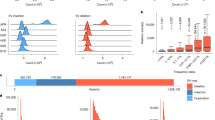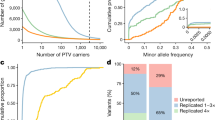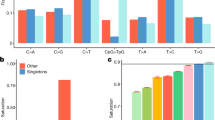Abstract
The UK Biobank Exome Sequencing Consortium (UKB-ESC) is a private–public partnership between the UK Biobank (UKB) and eight biopharmaceutical companies that will complete the sequencing of exomes for all ~500,000 UKB participants. Here, we describe the early results from ~200,000 UKB participants and the features of this project that enabled its success. The biopharmaceutical industry has increasingly used human genetics to improve success in drug discovery. Recognizing the need for large-scale human genetics data, as well as the unique value of the data access and contribution terms of the UKB, the UKB-ESC was formed. As a result, exome data from 200,643 UKB enrollees are now available. These data include ~10 million exonic variants—a rich resource of rare coding variation that is particularly valuable for drug discovery. The UKB-ESC precompetitive collaboration has further strengthened academic and industry ties and has provided teams with an opportunity to interact with and learn from the wider research community.
This is a preview of subscription content, access via your institution
Access options
Access Nature and 54 other Nature Portfolio journals
Get Nature+, our best-value online-access subscription
$32.99 / 30 days
cancel any time
Subscribe to this journal
Receive 12 print issues and online access
$259.00 per year
only $21.58 per issue
Buy this article
- Purchase on SpringerLink
- Instant access to full article PDF
Prices may be subject to local taxes which are calculated during checkout
Similar content being viewed by others
Data availability
The UKB aims to encourage and provide the widest possible access to its data and samples for health-related research in the public interest performed by all bona fide researchers from the academic, charity, public and commercial sectors, both in the United Kingdom and internationally, without preferential access for any user. The UKB’s publicly available Data Showcase (http://biobank.ndph.ox.ac.uk/showcase/) presents the univariate distributions and methods used for collection of all of the variables available for health-related research, enabling potential research users to explore which data are available and to plan research applications. All researchers who wish to access the resource must register with the UKB via its online access management system (https://bbams.ndph.ox.ac.uk/ams/). Once approved, researchers may apply (via the access management system) to access the resource for specific, well-defined research projects. At the time of publication, over 16,500 researchers were registered with the UKB and over 2,000 research applications were approved (see https://www.ukbiobank.ac.uk/enable-your-research/approved-research for a summary of research that is currently underway).
References
DiMasi, J. A., Grabowski, H. G. & Hansen, R. W. Innovation in the pharmaceutical industry: new estimates of R&D costs. J. Health Econ. 47, 20–33 (2016).
Dowden, H. & Munro, J.Trends in clinical success rates and therapeutic focus. Nat. Rev. Drug Discov. 18, 495–496 (2019).
Furtado, R. H. M. & Giugliano, R. P.What lessons have we learned and what remains to be clarified for PCSK9 inhibitors? A review of FOURIER and ODYSSEY outcomes trials. Cardiol. Ther. 9, 59–73 (2020).
Denison, H. et al. Proof of mechanism for the DGAT1 inhibitor AZD7687: results from a first-time-in-human single-dose study. Diabetes Obes. Metab. 15, 136–143 (2013).
Meyers, C. D. et al. Effect of the DGAT1 inhibitor pradigastat on triglyceride and apoB48 levels in patients with familial chylomicronemia syndrome. Lipids Health Dis. 14, 8 (2015).
Haas, J. T. et al. DGAT1 mutation is linked to a congenital diarrheal disorder. J. Clin. Invest. 122, 4680–4684 (2012).
Sabatine, M. S. et al. Evolocumab and clinical outcomes in patients with cardiovascular disease. N. Engl. J. Med. 376, 1713–1722 (2017).
Schwartz, G. G. et al. Alirocumab and cardiovascular outcomes after acute coronary syndrome. N. Engl. J. Med. 379, 2097–2107 (2018).
Cook, D. et al. Lessons learned from the fate of AstraZeneca’s drug pipeline: a five-dimensional framework. Nat. Rev. Drug Discov. 13, 419–431 (2014).
King, E. A., Wade Davis, J. & Degner, J. F. Are drug targets with genetic support twice as likely to be approved? Revised estimates of the impact of genetic support for drug mechanisms on the probability of drug approval. PLoS Genet. 15, e1008489 (2019).
Nelson, M. R. et al. The support of human genetic evidence for approved drug indications. Nat. Genet. 47, 856–860 (2015).
Nguyen, P. A., Born, D. A., Deaton, A. M., Nioi, P. & Ward, L. D. Phenotypes associated with genes encoding drug targets are predictive of clinical trial side effects. Nat. Commun. 10, 1579 (2019).
McKusick, V. A.Phenotypic diversity of human diseases resulting from allelic series. Am. J. Hum. Genet. 25, 446–456 (1973).
Plenge, R. M., Scolnick, E. M. & Altshuler, D.Validating therapeutic targets through human genetics. Nat. Rev. Drug Discov. 12, 581–594 (2013).
Abul-Husn, N. S. et al. A protein-truncating HSD17B13 variant and protection from chronic liver disease. N. Engl. J. Med. 378, 1096–1106 (2018).
Dendrou, C. A. et al. Resolving TYK2 locus genotype-to-phenotype differences in autoimmunity. Sci. Transl. Med. 363, 363ra149 (2016).
Diogo, D. et al. TYK2 protein-coding variants protect against rheumatoid arthritis and autoimmunity, with no evidence of major pleiotropic effects on non-autoimmune complex traits. PLoS ONE 10, e0122271 (2015).
Minegishi, Y. et al. Human tyrosine kinase 2 deficiency reveals its requisite roles in multiple cytokine signals involved in innate and acquired immunity. Immunity 25, 745–755 (2006).
Noh, H. J. et al. Integrating evolutionary and regulatory information with a multispecies approach implicates genes and pathways in obsessive-compulsive disorder. Nat. Commun. 8, 774 (2017).
Nioi, P. et al. Variant ASGR1 associated with a reduced risk of coronary artery disease. N. Engl. J. Med. 374, 2131–2141 (2016).
Dolgin, E. Massive NIH–industry project opens portals to target validation. Nat. Rev. Drug Discov. https://doi.org/10.1038/d41573-019-00033-8 (2019).
McCarthy, M. I. et al. Genome-wide association studies for complex traits: consensus, uncertainty and challenges. Nat. Rev. Genet. 9, 356–369 (2008).
Burton, P. R. et al. Genome-wide association study of 14,000 cases of seven common diseases and 3,000 shared controls. Nature 447, 661–678 (2007).
Bycroft, C. et al. The UK Biobank resource with deep phenotyping and genomic data. Nature 562, 203–209 (2018).
Yang, Y. et al. Clinical whole-exome sequencing for the diagnosis of Mendelian disorders. N. Engl. J. Med. 369, 1502–1511 (2013).
UK Biobank leads the way in genetics research to tackle chronic diseases. UK Biobank https://www.ukbiobank.ac.uk/learn-more-about-uk-biobank/news/uk-biobank-leads-the-way-in-genetics-research-to-tackle-chronic-diseases-1 (2019).
Diversity matters. Nat. Rev. Genet. 20, 495 (2019).
Gurdasani, D., Barroso, I., Zeggini, E. & Sandhu, M. S.Genomics of disease risk in globally diverse populations. Nat. Rev. Genet. 20, 520–535 (2019).
Fry, A. et al. Comparison of sociodemographic and health-related characteristics of UK Biobank participants with those of the general population. Am. J. Epidemiol. 186, 1026–1034 (2017).
Auton, A. et al. A global reference for human genetic variation. Nature 526, 68–74 (2015).
Dunham, I. et al. An integrated encyclopedia of DNA elements in the human genome. Nature 489, 57–74 (2012).
Lander, E. S. et al. Initial sequencing and analysis of the human genome. Nature 409, 860–921 (2001).
McCarthy, S. et al. A reference panel of 64,976 haplotypes for genotype imputation. Nat. Genet. 48, 1279–1283 (2016).
Methé, B. A. et al. A framework for human microbiome research. Nature 486, 215–221 (2012).
Holden, A. L., Contreras, J. L., John, S. & Nelson, M. R.The international serious adverse events consortium. Nat. Rev. Drug Discov. 13, 795–796 (2014).
Regeneron announces major collaboration to exome sequence UK Biobank genetic data more quickly. UK Biobank https://www.ukbiobank.ac.uk/learn-more-about-uk-biobank/news/regeneron-announces-major-collaboration-to-exome-sequence-uk-biobank-genetic-data-more-quickly (2018).
Van Hout, C. V. et al. Exome sequencing and characterization of 49,960 individuals in the UK Biobank. Nature 586, 749–756 (2020).
Karczewski, K. J. et al. The mutational constraint spectrum quantified from variation in 141,456 humans. Nature 581, 434–443 (2020).
Minikel, E. V. et al. Evaluating drug targets through human loss-of-function genetic variation. Nature 581, 459–464 (2020).
Liu, J. Z. et al. The burden of rare protein-truncating genetic variants on human lifespan. Preprint at bioRxiv https://doi.org/10.1101/2020.06.02.129908 (2020).
Povysil, G. et al. Assessing the role of rare genetic variation in patients with heart failure. J. Am. Med. Assoc. Cardiol. 6, 379–386 (2021).
Carss, K. J. et al. Spontaneous coronary artery dissection: insights on rare genetic variation from genome sequencing. Circ. Genom. Precis. Med. 13, e003030 (2020).
Dhindsa, R. et al. Identification of a novel missense variant in SPDL1 associated with idiopathic pulmonary fibrosis. Commun. Biol. 4, 392 (2021).
Cameron-Christie, S. et al. A broad exome study of the genetic architecture of asthma reveals novel patient subgroups. Preprint at bioRxiv https://doi.org/10.1101/2020.12.10.419663 (2020).
UK Biobank launches one of the largest scientific studies measuring circulating proteins, to better understand the link between genetics and human disease. UK Biobank https://www.ukbiobank.ac.uk/learn-more-about-uk-biobank/news/uk-biobank-launches-one-of-the-largest-scientific-studies (2020).
Acknowledgements
We thank everyone who made this work possible, including the UKB team, their funders and the dedicated professionals from the member institutions who contributed to and supported this work. We are especially grateful to the UKB participants who generously volunteered to take part in this research. This research has been conducted using the UKB resource under application number 26041.
Author information
Authors and Affiliations
Consortia
Contributions
J.D.S., P.G.B., E.W., J.W.D., C.H., A.K.L., R.M., H.J.N., S.W., E.N.S., J.F.W., C.D.W., E.A.T., J.D.O., W.J.S., H.J., S.S., H.R., G.H., P.N., S.P., M.R.M., A.B., L.J.M. and J.G.R. jointly supervised the research. J.D.S., W.J.S., A.B. and J.G.R. conceived of and designed the experiments. A.E.L. and J.D.O. performed the experiments. J.D.S., S.B., A.S., S.K., E.K., D.L., X.B., A.H., O.K. and W.J.S. analyzed the data. X.B., A.H., O.K., R.U., W.J.S. and J.G.R. contributed reagents, materials and/or analysis tools. J.D.S., S.B., A.S., P.G.B., E.K., W.J.S., S.S., H.R., P.N., S.P., M.R.M. and J.G.R. wrote the paper.
Corresponding author
Ethics declarations
Competing interests
J.D.S. is employed by and owns stocks in Bristol Myers Squibb. C.D.W. and H.R. are employees of Biogen and hold stock options at Biogen. E.N.S. is an employee of Takeda California. S.S. is employed by Takeda California and is a shareholder of Takeda and Johnson & Johnson. H.J.N. and J.W.D. are employed by AbbVie and may own AbbVie stock and/or options. A.K.L. is an employee of Pfizer. M.R.M. is an employee and stockholder of Pfizer. P.N. is an employee of and stockholder in Alnylam Pharmaceuticals. G.H. is a paid consultant to 54gene—a Nigerian genomics company. C.H. and S.P. are employees and stockholders of AstraZeneca. W.J.S., R.U., A.H., O.K., S.K., D.L., X.B., A.E.L., S.B., A.B., J.D.O. and L.J.M. are full-time employees of the Regeneron Genetics Center of Regeneron Pharmaceuticals and receive stock options and restricted stock units as compensation. J.G.R. is a full-time employee of the Regeneron Genetics Center of Regeneron Pharmaceuticals and receives stock options and restricted stock units as compensation. J.G.R. also provides (unpaid) advice, support and guidance to the UKB as a member of the UKB International Scientific Advisory Board. The other authors declare no competing interests.
Additional information
Peer review information Nature Genetics thanks Amalio Telenti, Matthew Nelson and Kaja Wasik for their contribution to the peer review of this work.
Publisher’s note Springer Nature remains neutral with regard to jurisdictional claims in published maps and institutional affiliations.
Supplementary information
Supplementary Information
Supplementary Note
Rights and permissions
About this article
Cite this article
Szustakowski, J.D., Balasubramanian, S., Kvikstad, E. et al. Advancing human genetics research and drug discovery through exome sequencing of the UK Biobank. Nat Genet 53, 942–948 (2021). https://doi.org/10.1038/s41588-021-00885-0
Received:
Accepted:
Published:
Issue date:
DOI: https://doi.org/10.1038/s41588-021-00885-0
This article is cited by
-
Investigating the sources of variable impact of pathogenic variants in monogenic metabolic conditions
Nature Communications (2025)
-
Rare genetic associations with human lifespan in UK Biobank are enriched for oncogenic genes
Nature Communications (2025)
-
Common genetic variants modify disease risk and clinical presentation in monogenic diabetes
Nature Metabolism (2025)
-
Ophthalmic drug discovery and development using artificial intelligence and digital health technologies
npj Digital Medicine (2025)
-
Genetic architecture of plasma metabolome in 254,825 individuals
Nature Communications (2025)



